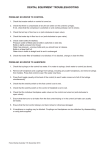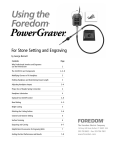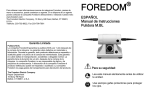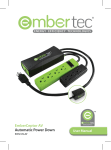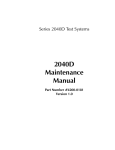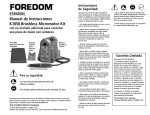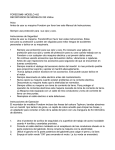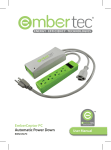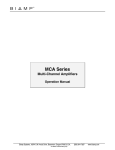Download Series TX Owner`s Manual
Transcript
Owner’s Manual Assembly, Operation and Service Manual for Series TX & LX Flexible Shaft Power Tools See Insert with Special Instructions for Heavy Duty Series TXH and LXH Models 2-Year Warranty For Your Own Safety • Please read this Assembly, Operation, and Service Manual before operating your Foredom power tool. • Always wear eye protection while using power tools. • Always use an accessory which has the same or a higher speed rating than your tool. Using an accessory with a lower speed rating can result in serious injury. • For the TX Series – Only use accessories rated for use at 15,000 RPM or higher. With the H.35 Handpiece use only accessories rated for 35,000 RPM or higher. • For the LX Series – Only use accessories rated for use at 5,000 RPM or higher. FOREDOM ® www.foredom.net • • • • 2 Contents Page Safety Instructions 2, 3 Foredom® Tools Assembly Instructions Assembly and Adjustment of Flexible Shaft, Sheath and Handpiece Connecting Foot or Manual Speed Controls Hanging Motor Installation 4 5-6 5 6 6 How-To Videos on www.foredom.net Click on our homepage link where Foredom’s National Sales Manager shows you the basics of using and maintaining flexible shaft machines. Click to View: 1. Intro & Proper Set-up 2. Safety Guidelines Foredom Handpieces and Accessories Attaching Accessories to Handpieces General Accessory Recommendations Operation —General Guidelines Maintenance Procedures Routine Cleaning and Lubrication Replacement of Worn Shaft and Sheath Replacement of Motor Brushes Repair and Storage Recommended Spare Parts and Supplies Motor Hangers 2-Year Warranty Contact Information 7-11 8 10-11 12 12-14 12-14 13-14 14 14 15 15 16 16 Safety Instructions entangled in the rotating accessory. Do not wear items such as neckties, necklaces, or bracelets when operating power tools. Be sure to tie back or secure long hair. Secure power tool to motor hanger or work surface. Flexible shaft power tools can “jump” at start up or vibrate during operation. The tool should be properly secured in order to prevent it from vibrating off of the motor hanger or work bench. Never operate any accessory at speeds above it’s maximum rated speed. When properly used, all of Foredom's accessories can be operated at the speed ratings listed in the Foredom Accessory Catalog or specified on kits and packages. Always find out the manufacturer's speed rating before using accessories other than those from Foredom. For added safety and comfort while using this power tool for carving or other applications, it is recommended that you wear a Before using your Foredom power tool, please read safety instructions. They are for your protection and should always be followed to reduce the risk of personal injury or damage to the tool. Always wear proper eye and face protection. Wear safety glasses or face shields whenever you operate a Foredom or any power tool to prevent serious eye or face injuries. Secure the work piece or item that you are working on in a vise or other work holding device. Holding it with your hand can result in serious hand injury. Always use a proper dust collection system or wear a respirator to prevent the inhalation of dust particles, polishing compounds, or other debris into the lungs. Do not wear loose fitting clothing or jewelry. Loose clothing or jewelry can become • • • 3. Handpieces & Accessories 4. Shaft and Sheath Maintenance – Grease and Replace 5. Motor Maintenance– Remove Dust, Replace Motor Brushes We have other product-related videos embedded throughout our website. We suggest that you take the time to watch these since they help to clarify product features, differences, and uses. Visit Foredom on www.youtube.com heavy canvas or leather apron. It will protect you from dust, debris and chips as well as help prevent injury if the handpiece slips off the workpiece. It will also help prevent loose clothing from getting caught in a rotating cutter, bur or other accessory. • Never use or continue to use any accessory which appears to be damaged, loose, vibrating, or out of balance. Inspect each accessory for cracks or flaws before using it. Avoid knots, imperfections in the wood or metal objects like nails, which could damage or catch the accessory. • Always insert the shank or arbor of an accessory or mandrel into the collet or chuck of the handpiece as far as possible in order to provide proper support and tighten the collet or chuck securely. • Never use excessive side pressure which may bend or break the shank or arbor of an accessory. Let the speed of the accessory do the work. • Do not stall the motor by jamming or using excessive pressure on the accessory. This can result in damage to the motor or flexible shaft. • Never operate the motor with the outer sheath removed from the flexible shaft. • Never modify the shielded plug on the TX or LXH motor cord in order to plug it into a Non-TX or Non-LX speed control or AC electrical wall outlet. Use only TXR, SXR, or EMX speed controls with all Series TX, TXH, LX, or LXH motors. • Always disconnect the power cord before servicing the motor or removing the flexible shaft or sheath. • Never operate your power tool during a perceptible power decrease. Turn power tool off and do not use until power is fully restored. • Use proper grounding procedures. This tool should be grounded while in use to protect the operator from electric shock. The tool is equipped with an approved 3-conductor cord and a 3-prong grounding type plug to fit the proper grounding receptacle. The green (or green and yellow) conductor in the cord is the grounding wire. Never connect the green (or green and yellow) wire to a live terminal. If your unit is for use on less than 150 volts, it has a plug that looks like sketch A below. An adapter (sketches B and C) can be used for connecting plugs as shown in sketch A to 2-prong receptacles. The green colored rigid ear, lug, etc., extending from the adapter must be connected to a permanent ground such as a properly grounded outlet box. Some jurisdictions, including Canada, prohibit the use of 3 to 2 prong adapters. Where prohibited, they should not be used. Use only 3-wire extension cords that have 3-prong grounding type plugs and 3-pole type plugs and 3-pole receptacles that accept the tool’s plug. Always disconnect the power cord before servicing the tool. Never use in an area where flammable vapors are present. 3 Foredom® Power Tools in this Manual You have purchased a fine quality power tool which will perform a wide variety of tasks difficult to do with any other kind of power tool. Foredom power tools are manufactured to high standards and will give you years of trouble-free performance with proper use and regular maintenance. Series TX Motors Hang-Up and Bench Style up to 15,000 RPM M.TX M.TXB M.TXM with built-in control Series LX Hang-Up and Bench Style high torque, low speed motors up to 5,000 RPM M.LX M.LXB M.LXM with built-in control Speed Controls –these are dedicated controls specific to Series TX, TXH, LX, and LXH motors C.TXR Foot Control C.SXR Foot Control in plastic housing in metal housing 4 C.EMX Dial Control Your Series TX or LX flexible shaft power tool consists of a motor, flexible shaft and sheath, speed control (foot or manual) and a handpiece. Locate and identify all components, parts and accessories you purchased before discarding the packing list and any materials that came with your power tool. Assembly Instructions Always make sure your power tool is unplugged during assembly! Please follow these directions to assemble and adjust the shaft and sheath. After identifying all the components of your power tool, assemble it in the following manner: To check the shaft and sheath you must first Assembly and Adjustment of Flexible remove the handpiece. Inner Shaft, Outer Sheath, & Handpiece Proper assembly and adjustment of the flexible shaft and sheath are critical for the correct operation of your Foredom power tool. The exposed tip (handpiece end) of the flexible shaft (with handpiece removed) must extend 3/4″ (19mm) beyond the sheath. The handpiece is easy to remove from the flexible shaft. To remove: 1. First make sure your power tool is unplugged. Simply pull the handpiece off the shaft and sheath with a firm grip. To Re-attach Handpiece: while holding the black colored metal outer sheath tip facing upward, turn on the motor so that it is running at about half speed and then turn it off. While the inner key tip is still rotating, grip the handpiece and push it onto the sheath tip with one firm motion Important Note: The shaft and sheath until it snaps into place (shown below). This should be checked and adjusted (if necesprocedure will align the key tip into the keyway slot sary) even if you received them assembled (as shown below at left). To verify and attached to the motor! this, insert and tighten an accessory metal into collet or chuck, turn on control keyway key tip end of shaft sheath to low speed and observe that the slot tip accessory rotates smoothly. IMPORTANT! inside, back end of handpiece 2. With the handpiece removed, place the entire unit on a flat surface with the shaft and sheath extended straight. Loosen the set screw on the motor connector. Adjust the exposed tip (handpiece end) of the flexible shaft so that it extends 3/4″ (19mm) beyond the sheath. This is done by moving the sheath in or out of the motor connector (motor end). IMPORTANT! 3. When the correct adjustment is made, re-tighten the set screw in the motor connector and re-attach handpiece onto the flexible shaft. 5 Connecting Foot Speed Control socket connector for motor plug The electrical specifications for your power tool are listed on the back of the motor. It will show the proper voltage and currents to use with your power tool. Be sure to follow the grounding instructions on page 3 of this manual while attaching the speed control to a power outlet. TX, TXB, LX, and LXB Motors can only be plugged into TXR or SXR Foot Controls or an EMX Dial Control on AC Current Only. Serious motor damage will result if other speed controls are used or if motor is directly plugged into an AC electrical outlet. To connect the TXR or SXR foot control to the motor, insert the shielded 3-prong plug on the motor power cord into the socket connector on the shorter power cord on the foot control. With the foot control in the “off” position (not depressed), plug the 3-prong plug on the longer power cord from the foot control into a proper 3-wire power outlet. Be sure to follow the proper grounding instructions described on page 3 of this manual. When your foot is not pressing the foot control, the motor should not be running. It is also important to hold the handpiece securely before engaging the foot pedal to the “on” position. Your foot must maintain steady contact with the pedal during operation. Holding the handpiece in your hand, begin with a light touch, start out slowly and gradually increase the speed. Finding the right speed for any specific task is a matter of experimentation and experience. Connecting Table-Top Dial Speed Control TX, TXB, LX, and LXB motors can also use the EMX dial speed control on AC current. Connect the control to the motor by inserting the shielded 3-prong plug on the motor power cord into the socket connector on the shorter power cord on the dial control. With the dial indicator arrow in the “off” position on the control, plug the 3-prong plug on the longer power cord from the dial control into a proper 3-wire power outlet (see page 3). Holding the handpiece in your hand, begin with a light touch, start out slowly and gradually increase the speed. Finding the right speed for any specific task is a matter of experimentation and experience. 3-prong plug connects to power outlet shielded plug connects to speed control only Use only TXR, SXR, or EMX speed controls. Never modify the shielded plug on the motor cord in order to use it with a different control or to plug it directly into an AC electrical power outlet. Hold the handpiece securely before turning the motor on with either the foot or dial control. Hanging Motor Installation TX and LX Motors should be hung up about 30″– 40″ above the work surface and to the right of the work if you are right handed or to the left of the work if you are left handed. Use a safety clip or hook like the one shown to prevent the motor from jumping or twisting off an open hook at start up or during use. Properly securing the motor will help to prevent injury to the user. All Foredom motor hangers have this type of safety clip (see page 15). If an “open hook” is used be sure to secure the motor to it with wire or tape. socket connector for motor plug 3-prong plug connects to power outlet To minimize repetition, we sometimes drop prefixes associated with Foredom part numbers. Officially, Motors begin with M. (M.TX), Handpieces with H. (H.30®), and Speed Controls with C. (C.TXR). 6 ® FOREDOM Interchangeable Handpieces (burs not included) H.25 H.8 H.28 H.8D H.30® H.10 H.35 H.10D H.43T H.15 H.44T H.15D H.18 H.18D H.50 H.52 H.52D H.20 H.20D See insert for special square drive handpieces for use with Series TXH and LXH motors. 7 Attaching Accessories to Handpieces Directions for attaching accessories to handpieces vary according to the type of handpiece being used. Locate the model number of your Foredom handpiece from the photos on page 7. Always wait for the motor, flexible shaft and accessory to come to a complete stop before changing an accessory. (Handpieces listed in brackets are for use with Series TXH and LXH models only.) Attach the accessory according to the following: Collet Types – 8, 8D, 25, (25H), 28, 28SJ, (28H), 35, 35SJ, 43T, 44T, 44TSJ, & (44HT) Handpieces: A collet is an interchangeable slotted cylinder inserted tightly into the interior of a handpiece to hold a bur or other rotary accessory. The diameter size of the collet must match the diameter of the accessory’s shank. General Directions: Be sure to use the correct shank size. The correct shank will fit snugly inside the collet. Caution: Never tighten a collet unless an accessory has been inserted. Tightening an empty collet or inserting an accessory which is too small or too large may damage the collet. 8, 8D, and 8SJ Handpieces: To change a collet: slide back the chuck guard and use one wrench to hold the spindle and the other to unscrew the chuck nut by turning counterclockwise. Remove chuck nut to expose collet and pull collet out of handpiece shaft. Slip new collet in place and tighten chuck nut with wrenches. To insert accessory: insert shank as far as possible into the collet. Tighten chuck nut. Test for a secure hold by pulling on accessory. Remove wrenches. To release an accessory, follow the same steps. Accessories can be released when chuck nut is loosened. If accessory does not run true, loosen chuck nut, rotate accessory, and retighten. 25, (25H), 28, 28SJ, (28H), 35, 35SJ, 43T, 44T, 44TSJ & (44HT) Handpieces: To change a collet: 1. Insert pin provided into the pilot hole and through the spindle hole (turn spindle to align holes). Apply wrench and unscrew chuck nut by turning counterclockwise. 2. Remove chuck nut to expose collet. 3. Pull collet out of Pilot or handpiece spindle. Spindle Hole 4. Slip new collet in place and screw on chuck nut. 5. Remove pin. 8 25, (25H), 28, 28SJ, (28H),35, 35SJ, 43T, 44T, (44HT), and 44TSJ Collet Handpieces: To insert or change accessories: insert pin provided into the pilot hole and through the spindle hole (turn spindle to align holes). Loosen chuck nut slightly with wrench provided. Insert shank of accessory into collet. Tighten chuck nut with wrench, keeping pin in pilot hole. Test for a secure hold by pulling on accessory. Remove pin. Chuck Type – 30®, 30SJ, and (30H) Handpieces: These handpieces have a geared 3-jaw #0 chuck. Open chuck jaws as far as necessary with key provided. Insert shank of accessory fully into the chuck. Tighten jaws with chuck key until accessory is secure and centered. If accessory does not run true, reopen jaws, rotate accessory and retighten. To release accessory, simply reopen chuck jaws with key and pull out accessory. Hammer Type – 15, 15D, & 15SJ Handpieces: These handpieces have a threaded spindle. Thread anvil or stylus into threaded spindle as far as it will go with clockwise motion. Insert pin provided into cross hole in anvil or stylus. Tighten and remove pin. To release accessory, insert pin into the cross hole and unthread. Quick Change Type – 10, 10D, 18, 18D, 18SJ, 20, 20D, 20SJ, 52, 52D, and 52SJ Handpieces: Keep an accessory in these handpieces at all times, during both operation and storage, or damage to the collet and handpiece may result. These handpieces accept only 2.35mm (3/32″) shank accessories. 10 and 10D Handpieces: To insert bur, turn lever 180º clockwise towards the back (shaft connection end) of handpiece. Insert or change a 2.35mm (3/32″) shank bur and turn lever 180º forward counterclockwise. Make sure lever is completely locked into the forward position. Never change burs while handpiece is running. To minimize repetition, we sometimes drop prefixes associated with Foredom part numbers. Officially, Motors begin with M. (M.TX), Handpieces with H. (H.30®), and Speed Controls with C. (C.TXR). 18, 18D, and 18SJ Handpieces: These handpieces have a lever on the side of the handpiece. Push the spring loaded lever down to open the collet and release the shank of accessory (2.35mm or 3/32″ only). Insert accessory with the lever held down. Never push lever down while handpiece or flex shaft are rotating. Attaching Accessories to Handpieces Quick Change Type — continued 20, 20D, 20SJ Handpiece: This handpiece has a lever action collet release mechanism. Wait for the motor, flexible shaft, and accessory to come to a complete stop before turning the lever to open the collet and remove or insert accessory (2.35mm or 3/32″ only). Turn lever 90˚ to left or right to open collet and change an accessory. To close the collet turn the lever back to the position parallel to the handpiece. 52, 52D, and 52SJ Handpieces: These quick change handpieces have a unique push/pull collet release mechanism for rapid accessory changing (2.35mm or 3/32″ only). Wait for the motor, flexible shaft, and accessory to come to a full stop before opening the collet. After accessory has stopped rotating, pull the top grip forward with one hand while holding the bottom of the handpiece with the other. Remove the accessory and insert the shank of the new one fully into the collet. Push the top and bottom portions together. Chisel Type — 50 and 50C Handpieces (50C includes set of six chisels): Inserting a chisel into this reciprocating handpiece should be done while the motor is in the “off” position, or with the handpiece disconnected. Loosen the locking nut with the 12mm spanner wrench provided by unscrewing it counterclockwise. Insert the tang fully into the plunger shaft. Tighten the locking nut clockwise until tool is held securely. Do not over tighten. Handpiece Lubrication (See page 7 for handpiece photos.) 8, 18, 20, 25, (25H), 28, 30®, (30H) 35, 43T, 44T, (44HT) and 52: These handpieces have been permanently lubricated. Their greased-shielded ball bearings should absolutely not be lubricated. (Handpieces listed in brackets are for use with Series TXH and LXH models only.) 10 and 10D: Lubrication should not be required for the first 2–3 months of continuous use. Then, approximately every two weeks of use, lubrication of the front and back ends of the handpiece is required. Follow the detailed instructions that come with your handpiece. 8D, 10D, 15D, 18D, 20D, and 52D Handpieces with Duplex Spring Connections: Approximately every 20 hours of operation apply 1 or 2 drops of Foredom oil (Part No. MS10005) into the hole in the duplex spring collar next to the sheath connector. This will provide sufficient lubrication for both the duplex spring connection and the handpiece spindle. 15, 15D: Clean off any dirt to prevent foreign matter from falling inside the handpiece. Put two drops of Foredom oil into the oil hole in the side of the housing. Run the handpiece slowly to distribute the oil. Lubricate every 100 hours of use. 50: After every 200 hours of use you should clean and lubricate this handpiece. The old grease must be cleaned off of the interior cam chamber and replaced with new lubricant (Part No. MS10008). Follow the detailed instructions that come with your chisel handpiece. Visit www.foredom.net How-To Videos on Foredom flex shaft set-up, maintenance and operation! 9 General Accessory Recommendations Foredom’s wide assortment of rotary accessories makes your flexible shaft power tool very versatile. Use it for grinding, sanding, carving, engraving, brushing, cutting, buffing, and polishing on virtually any material. The Foredom Accessory Catalog offers the right accessories for your specific applications. Accessories may be purchased from your local dealer or directly from Foredom. Visit our online store at www.foredom.net. Always let the speed of the power tool do the work. Avoid forcing the tool or applying too much pressure. Experience will help you choose the right speed for the work you are doing. It's always a good idea to practice on a scrap piece of the same material you plan to use to determine the best accessories and speeds. Always follow the manufacturer’s RPM or speed recommendations when selecting accessories. Your motor is supplied with a variable speed control that allows you to operate it at the most suitable speed for each job. TX Series motors have a maximum speed rating of 15,000 RPM. LX Series motors have a maximum speed rating of 5,000 RPM. Always use an accessory which has the same or a higher speed rating than your tool. Using an accessory with a lower speed rating can result in serious injury. Abrasive Points, Wheels, and Discs Use Aluminum Oxide (red color) for fast cutting on high-tensile, tough materials such as steel and malleable iron. Also use on glass and porcelain, etc. Aluminum Oxide (white color) points have an extremely fine grit for producing a fine, high finish on high-tensile materials including stainless steel and glass. Rubber Bonded Abrasive Wheels are used for removing rust and for polishing with various grits. For best results, use finer grits for finishing at high speeds and coarser grits for stock removal at lower speeds. Abrasive Discs are for grinding, smoothing, and cleaning glass, high speed steel, and other tough materials. 10 Ruby Carvers have ruby crystals firmly bonded to a metal frame. These long lasting abrasives provide a smooth finish on hard materials such as steel, porcelain, glass, acrylic, soft and precious metals and wood. Unique CeramCut Blue Stones are made from a mixture of special man-made ceramic grain and aluminum oxide bonded together. The ceramic provides a faster cutting action and is more durable so burs hold their shape longer than standard abrasives. They are ideal for use on any hard metal such as steel, stainless steel, chrome cobalt, platinum and titanium, as well as on wood. Unique V Stones have extra hard and long lasting vitrified aluminum oxide and ceramic grain with a special glass bead binder that makes them extremely long lasting, cool running and very aggressive — 40 to 60 grit. They work on the same materials as CeramCut Blue Stones, but much more aggressively. Unique Scotch-BriteTM Radial Bristle Discs from 3M have thin flexible plastic bristles that get into hard to reach areas on flat and curved surfaces. Use on metal, acrylic, plaster, ceramics and wood without the need for compounds. These long lasting abrasives come in many size diameters and grits. Unique CW Ceramic Impregnated Polishing Wheels are used for smoothing and polishing precious metals including platinum, gold, and silver. They also work on titanium, chrome cobalt, and all hard alloys. Wheels are 7/8″ in diameter and come in six grits. Burs and Cutters Vanadium Steel Cutters are suitable for all materials except hardened steel and glass. They are used for cutting grooves and countersinking in soft materials, carving and hollowing woods, slotting and grooving woods, plastics, etc. Steel Cutters are good for shaping, grooving, slotting and cutting in wood, plastic and soft metals. Use Carbide Burs on wood, plastic and tough alloys. Carbide is generally referred to as the “hardest man-made metal”. High Speed Fluted Burs are used for fine detailed work on metal and other hard materials. Generally use medium speeds for stock removal and higher speeds for finishing work and when using smaller points. Cut-Off Wheels are used to cut off, groove, and trim metal, wood and ceramics. Unique Typhoon ® Carbide Burs provide very fast and aggressive material removal. Made for use on soft and hard woods, diestone, and plastics (do not use Typhoon burs on metal). They have aligned teeth that leave a smoother finish than other types of non-fluted tungsten carbide burs. Drills Step Drills are used to drill wood, precious metals, mild steel, bone, and mother of pearl. Diamond Coated Twist Drills, made of wire gauge steel with diamond coating, are used to drill extremely fine holes in stone, ceramics, tile, glass, and hard metals. Plated and Sintered Diamond Points and Discs are used to remove stock from extremely hard materials such as tungsten and tantalum carbide cutting tools, dies and molds, broaches, and for grinding and pre-polishing synthetic jewels and precious metals, fiberglass, reinforced plastics, PVC and ceramics. Sintered diamonds last far longer than plated diamonds and can be re-sharpened as desired with a wet dressing stone to expose new diamond particles. Sanding Drums, Bands, and Discs These are used for removing rust, smoothing rough surfaces and for sanding jobs on wood, plastic and metal. (Avoid using too much pressure which will cause clogging or a build-up on the work surface.) For best results, use medium speeds for coarser grits and larger diameters. Use higher speeds for finishing work or with smaller sizes. Unique 3M Ceramic Purple Coated Abrasive Bands and Discs contain patented CubitronTM ceramic aluminum oxide mineral that sharpens itself with use. They last 2 to 4 times longer than traditional aluminum oxide discs and remove material faster with less heat and loading. Cotton or Felt Bobs and Buffs Solid Felt Buffs or Bobs are used in combination with gritty or smooth compounds for a variety of buffing and polishing operations on plastic, wood, and metal. They vary in shape and come in three hardnesses — medium, hard, and rock hard. Loosely-stitched Soft Cotton Buffs are used for delicate work on precious metal and during polishing operations. Generally use high speeds for cutting down and buffing. Medium speeds are used for more delicate, precise work and for polishing. Brushes Miniature Power Brushes are generally used on metal surfaces and hard-to-reach areas. They are ideal for deburring, surface finishing, edge blending, roughening to create a good bonding surface, and general cleaning. Use high speeds for cleaning and deburring. Medium speeds are needed when cleaning hard-toreach areas and edge blending. Unique Scotch-Brite TM Radial Bristle Discs from 3M have thin flexible bristles that get into hard to reach areas on flat and curved surfaces. Use on metal, acrylic, plaster, ceramics and wood without the need for compounds. They can sand, smooth, polish, or burnish metal, plastic, or wood to a bright finish. Compounds Foredom has seven different compounds. In addition to Emery, Tripoli, and Red and White Rouges, there is unique Platinum Blue for pre-polishing and cutting down platinum and other metals, and for final polishing unique Platinum White (8000 grit) that produces a deep luster on platinum, other metals, and acrylics. Carnauba is the hardest wax available. It produces a high luster on wood and painted surfaces. 2″ Wheels and Discs for Angle Grinder Attachment Foredom recently introduced several types of wheels with 3/8″ arbor holes for grinding, deburring, shaping, and cutting on various materials. Also new are various types of psa backed abrasive discs, screens and velcro heads for sanding on wood, metal, plastic, glass, stone and more. Introduced in 2010, Foredom’s Angle Grinder Attachment is designed for use on the H.30®, H.30H, or H.30SJ Chuck-Style Handpieces. It is excellent for a broad range of sanding, polishing and finishing work with 2″ and smaller discs and 3/8″ arbor hole wheels. Bur and Tool Holders Foredom has three rotating bur holders and two small holders with covers. Two of the rotating models have center cups for holding small tools such as files and screwdrivers. A bur holder is the perfect companion product for your collection of burs, drill bits, and other accessories of various size shanks. The Foredom Accessory Catalog features the right accessories for your specific applications. Accessories may be purchased from your local dealer or directly from Foredom. Contact: The Foredom Electric Company, 16 Stony Hill Road, Bethel, CT 06801 Phone: (203)792-8622 • Fax: (203)796-7861 Visit our online store at www.foredom.net. 11 Operation – General Guidelines Read all the safety instructions in this manual before operating your Foredom® Power Tool. Proper eye and face protection must be worn to protect you from injury caused by flying debris, chips, or sparks which might result from the work being done. It is possible to use rotary or chisel handpieces not made by Foredom with your Foredom flexible shaft power tool. However, this is not recommended since their function and safety cannot be assured by Foredom. Your Foredom motor may be operated in a vertical or horizontal position, but it should not be enclosed or confined so as to restrict air circulation. If the motor is hung up above a workbench, be sure it is fastened securely to the wall or motor hanger. The motor may develop a high operating temperature (up to 100°F + ambient) after prolonged use, and it will be too hot to hold. This will not harm the motor which is designed to operate at this temperature for prolonged periods. Do not force the tool Let the speed of the tool do the work. Avoid using too much pressure. Generally, slower speeds are used for rougher, heavier work or when greater control over the accessory is required for precise, delicate work. Higher speeds are used for buffing, cutting and polishing. Read Accessory Recommendations on pages 10 and 11 of this manual. Voltage Decreases Never operate a power tool during a perceptible power decrease. Turn off tool and unplug until full power is restored. Always wear proper eye and face protection when operating a Foredom power tool. To turn motor off, remove foot from foot pedal speed control, or turn dial speed control to “off” position. 12 Do Not Do This! Do Not Do This! Minimum Operating Radius 34″ radius 53 Do not bend shaft and sheath at tight angle When operating your Foredom tool be careful not to bend the flexible shaft too much at either the handpiece or motor shaft connections. Shafts and sheaths last longer when they are used without sharp bends. If used at angles or loops, wear will occur at the points of greatest friction. Excessive heat and wear will occur if the bend is too great. Follow these guidelines for trouble-free use: a 4″or larger radius, as shown, should be maintained for shafts on all motors. In its normal curved position, all Foredom TX and LX Series flexible shaft power tools can tolerate up to 24 lbs. of torque. The Series TXH and LXH can withstand 50 lbs. of torque before breaking. There is no way to avoid ultimate wear and under normal conditions a flexible shaft machine may require several replacement shafts and sheaths during its lifetime. (Follow shaft and sheath assembly instruction in the Assembly section of this manual.) Maintenance Procedures Always make sure your power tool is unplugged during maintenance procedures! It is very important to routinely clean your Foredom® Power Tool and lubricate the shaft (NOT the motor), especially in areas that generate a lot of dust. Dirt and improper lubrication are the most common causes of poor operation and excessive wear. Note: The motor has permanently lubricated ball bearings and does not require additional lubrication. Routine Cleaning of Motors Foredom motors need air circulation through the motor housing to remove waste heat and cool the windings. Inlet and outlet slots provide the means for air flow. However, saw dust and conductive debris (like metal filings or gold dust) can enter in through these slots. If not cleaned regularly, dust can collect, making a bridge between parts, causing an electrical short. In high dust environments, Foredom recommends cleaning the motor every 40 hours of use. To remove dirt and dust buildup, motor brushes should be removed, cleaned and replaced, and air should be blown through the motor. Routine Cleaning and Lubrication of Flexible Inner Shaft The shaft should be checked, wiped clean, and re-lubricated with grease every 50 hours of use. With every 200 hours of use, the shaft should be thoroughly cleaned with solvent and lubricated. Use Foredom flex shaft grease (p/n MS10006) or high quality white lubricating grease. Exposing the Inner Shaft 1. Remove handpiece (see page 5). 2. Loosen set screw on motor connector. 3. Slide outer sheath out of motor connector and wipe shaft clean. 4. Apply a very light coating of lubrication to shaft starting at the top and working downward to about three inches from the handpiece end. Apply grease with your finger tip or small brush. Don’t overdo, apply a light film of grease. Once the machine is running, the shaft itself will spread the grease. If too much grease is applied, the excess will work its way into the handpiece and eventually seep out between the handpiece and sheath. For this reason, apply a bit less near the handpiece end of the shaft. Never operate the motor with the outer sheath removed from the flexible shaft. 5. Replace and adjust sheath so that shaft key tip extends 3/4″ (19mm) from sheath. Retighten the set screw in motor connector. See page 5, No. 2. 6. Clean outside of sheath by wiping with a cloth. 7. Hang and run the motor for about 10 minutes before attaching the handpiece to allow enough time for the grease to warm up, spread and drain off. Wipe off any excess grease at tip end of sheath. 8. Re-attach handpiece. See page 5. IMPORTANT! Visit www.foredom.net How-To Videos on Foredom flex shaft set-up, maintenance and operation! 13 Always make sure your power tool is unplugged when conducting maintenance procedures! Replacement of Worn Shafts and Sheaths Visit www.foredom.net How-To Videos on Foredom flex shaft set-up, maintenance and operation! Shaft and Sheath Adjustment Shafts and sheaths last longer when they are not used at sharp angles or loops, since wear occurs at the points of greatest friction. There is no way to avoid ultimate wear, and under normal conditions a flexible shaft machine may require several replacement shafts and sheaths during its lifetime. To expose the inner shaft follow steps 1, 2, and 3 on the previous page. Next, remove motor connector with 1″ open end or adjustable wrench. Motor connector has a left hand thread and must be turned clockwise (right) for removal. IMPORTANT! Place the entire unit on a flat surface with shaft and sheath extended straight. Adjust the exposed tip of the flexible shaft at the handpiece end so that it extends 3/4″ (19mm) beyond the sheath. This is done by moving the sheath in or out of the motor connector. When the correct adjustment is made, tighten the screw in the motor connector. Replacement of Motor Brushes Loosen set screw on the flexible shaft motor coupling and slide shaft off the motor shaft. Installation of New Shaft 1. After removing old shaft, loosen set screw on the new flexible shaft motor coupling and slide coupling onto motor shaft. 2. Tighten set screw securely onto the flat of the motor shaft. 3. Grease shaft prior to putting on the sheath. (See lubrication instructions on page 13.) set screw motor coupling motor shaft 4. Slide motor connector back up over the shaft and tighten to the left (counterclockwise). 5. Slide sheath over flexible shaft with plain fitting directed toward the motor and into the motor connector. (Each end of the sheath has a metal fitting. One is plain, the other has a groove around it to fit the handpiece.) 6. Adjust the shaft (page 5 and top right) and tighten sheath set screw in motor connector. 14 Motor brushes should be checked for wear periodically. When new they are approximately 3/4″ (19mm) long. Replace them when they have worn to 1/4″ (6mm). To remove brushes, disconnect motor power cord and unscrew the brush caps. Remove the worn motor brushes, replace with new motor brushes, and screw motor brush caps back on. Be sure to replace both motor brushes even if one of them is less worn than the other. New Motor Brush Motor Brush that needs replacement Recommended Spare Parts & Supplies The following parts and supplies are recommended as spares to keep on hand to insure continuous operation of your Foredom power tool. • Pair Motor Brushes (MP319P) Sheath (S-77) • Inner Shaft (S-93) • Foredom Flexible Shaft Grease (MS10006) • Motor Connector (UA111P) Motor Hangers Foredom motor hangers have bases that can be screwed or clamped to a bench. They keep hang-up motors at just the right distance for optimal use. Safety clips at the top prevent the motor from jumping or twisting off at start up and during use. Motors that slip off an open hook can cause serious injury. • Outer For Series TX, TXB, TXM, LX, LXB, and LXM MSMK-16 Maintenance Kit which contains: flexible shaft (S-93) pair motor brushes (MP319P) Foredom flexible shaft grease (MS10006) Owner’s Manual Repair Services Authorized repair service is available at the Foredom factory in Bethel, CT. Send items for repair to the factory marked: “Attention: Repair Department” The Foredom Electric Company 16 Stony Hill Road, Bethel, CT 06801 Enclose the item(s), a packing list, and information regarding the problem or repairs required. Estimates of repair cost will be made upon request. If the cost (labor plus parts) is more than fifty percent of the price for a new replacement we will contact you and recommend a trade-in offer. Storage Store your Foredom power tools in a DRY, clean, dust-free area, and out of the reach of children. Motor Hanger MAMH-1 can hang either one or two motors. It comes with MABC-1 Clamp that clamps onto a workbench & MAHR-2 Handpiece Rest. Motor Hanger MAMH-2 can hang either one or two motors. It comes with MABC-2 Base that screws into a workbench and MAHR-2 Handpiece Rest. Visit www.foredom.net How-To Videos on Foredom flex shaft set-up, maintenance and operation! 15 LIMITED WARRANTY Series TX, TXH, LX, and LXH Flexible Shaft Power Tools Foredom warrants the Series TX, TXH, LX, and LXH Motors to be free of defects in material or workmanship for a period of 2 years after purchase. During the warranty period, the defective product will be repaired or replaced without charge or, at our option, the purchase price will be refunded. This warranty does not cover damage caused in transit or by accident, misuse, or ordinary wear of shafts, sheaths, bearings, armature, and motor brushes. . ALL IMPLIED WARRANTIES, INCLUDING BUT NOT LIMITED TO WARRANTIES OF FITNESS AND MERCHANTABILITY, ARE HEREBY LIMITED IN DURATION TO A PERIOD ENDING 2 YEARS FROM DATE OF PURCHASE, AND WE WILL NOT BE LIABLE OR RESPONSIBLE FOR ANY SPECIAL OR CONSEQUENTIAL DAMAGES. Repair or replacement will be made at our option if the product is returned post-paid to: The Foredom Electric Company 16 Stony Hill Road Bethel, CT 06801 All warranty repairs must be done at the factory at the above address. We will not pay any shipping or transportation charges. Handpieces have a 90 day warranty. Shafts, sheaths and duplex springs are not covered by this warranty since they are especially sensitive to the pressure and stress variables of the individual operator. This warranty only covers the original purchaser of the product. Some states do not allow limitations on how long an implied warranty lasts or the exclusion or limitation of incidental or consequential damages so the above limitations may not apply to you. This warranty gives you specific legal rights, and you may also have other rights which vary from state to state. Please retain your proof of purchase for warranty repairs. Contact Information If you have a warranty issue with your Foredom power tool please use the contact information below. For more information on Foredom machines, handpieces or accessories, contact your local dealer. When no local dealer is available contact Foredom at: The Foredom Electric Company 16 Stony Hill Road, Bethel, CT 06801 Tel.: (203) 792-8622 • Fax: (203) 796-7861 Email: [email protected] FOREDOM ® The Foredom Electric Company 16 Stony Hill Road, Bethel, CT 06801 www.foredom.net Form 902 n 12/11 Printed in U.S.A.


















